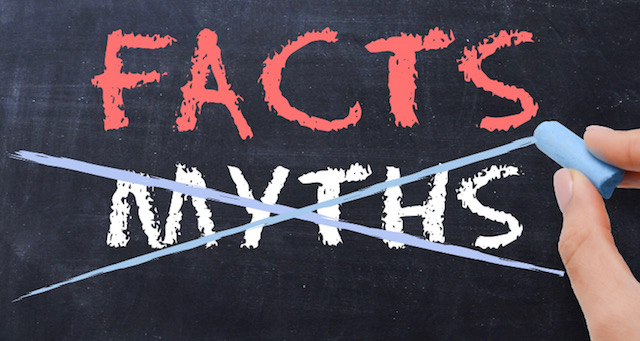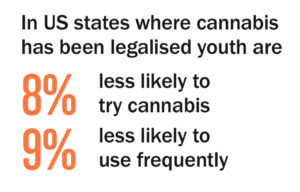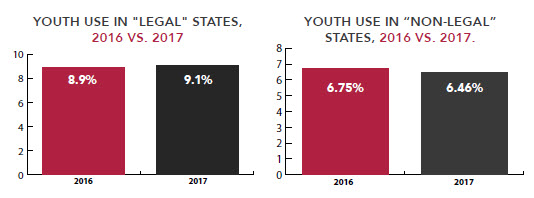
 On Friday, Radio NZ reported that the Drug Foundation say they are committed to keeping the public informed, fear mongering to a minimum and misinformation out of the news, ahead of the cannabis referendum.
On Friday, Radio NZ reported that the Drug Foundation say they are committed to keeping the public informed, fear mongering to a minimum and misinformation out of the news, ahead of the cannabis referendum.
The head of the Drug Foundation said
“I think the public can make up their mind, they can see through the misinformation, the hysteria [and] fear mongering that has been put out there at the moment, we can address that,”

So in their model for regulation released on Friday, this image was front and center.
Pretty impressive.
This one study – published in JAMA Pediatrics – purports to show the legalisation of marijuana leads to a reduction in teen use of the substance.
Here’s the problem. This study, funded in part by the pro-drug legalisation Charles Koch Foundation, is flawed for several reasons:
- It is based on the CDC YRBS, which completely omits Oregon and Washington – two large legal states – in 2017
- It also excludes young people who are not in school, such as dropouts
- According to the most comprehensive survey on drug use, the National Survey on Drug Use and Health — which includes all young people in households, not just those who gave permission to take a school survey — youth use of the drug is on the rise in legal states while declining in states that have not legalized the substance
- The study was partially funded by the Charles Koch Foundation, which is partially dedicated to legalizing marijuana (like Koch Industries)
“To put it simply, this study is awash with problems,” said Dr. Kevin Sabet, founder of Smart Approaches to Marijuana (SAM) and a former senior drug policy advisor to the Obama Administration. “The data here runs counter to what we see from the National Survey on Drug Use and Health: youth use is on the rise in ‘legal’ states while declining elsewhere. If you truly think that the legalisation, commercialisation, and normalisation of marijuana has led to less young people using it, I have a bridge to sell you.”
According to NSDUH data, the percentage of youth aged 12-17 using marijuana is declining faster in states where marijuana is not “legal,” and overall use is high in legal states while declining in non-legal states. Further, the percentage of youth in this age range using the drug in “legal” states was 7.7% versus 6.2% in non-legal states.

Ironically, in 2014, this same publication – JAMA – published an article purporting that states that have legalized marijuana saw a reduction in opioid overdoses over states that did not. In the years since, this study has been among the key talking points of the marijuana industry and its supporters. Then just last month, a study using the same methods and published in the same journal showed the completely opposite result. When it comes to drug policy, we simply cannot put all of our eggs in one basket.”
Also to note, the same researchers authoring this study have also previously claimed marijuana legalization reduces traffic fatalities (although the overwhelming majority of state data shows otherwise) and reduces suicide (although numerous studies show use of high potency marijuana is linked with suicide ideation).
And just to confirm how questionable this study was as stand-alone proof, even the CNN coverage of the report noted concerns:
The paper had some limitations, including that only an association was found in the study — not a causal relationship — and more research is needed to determine why this association exists. “Because many recreational marijuana laws have been passed so recently, we do observe limited post-treatment data for some of these states,” Anderson said…
The CNN report then went on to show how inconsistent it was with other research
For instance, a 2018 report from the Colorado Division of Criminal Justice Office of Research and Statistics found that the proportion of high school students in the state who said they used marijuana ever in their lifetime or in the past 30 days remained statistically unchanged from 2005 to 2017.
Meanwhile on the national front, the overall prevalence of marijuana-only use among youth in the United States since the early 1990s increased from 0.6% in 1991 to 6.3% in 2017, according to a study published in the American Journal of Public Health on Wednesday.
If this is the Drug Foundation’s definition of being “committed to keeping the public informed, fear mongering to a minimum and misinformation out of the news“, then perhaps the first place to start might be in their own policy analysis and presentation.
They may even be interested in purchasing that bridge.
COMING NEXT: The (multiple) problems with their ‘model for regulation’.
